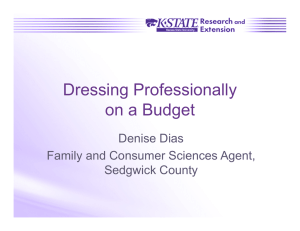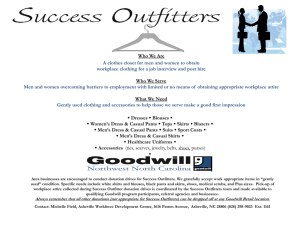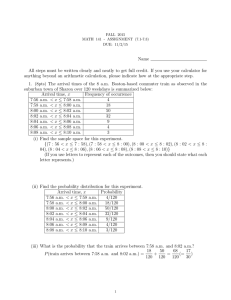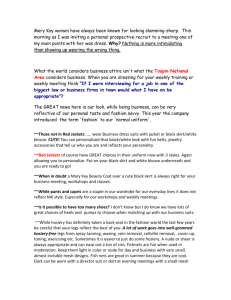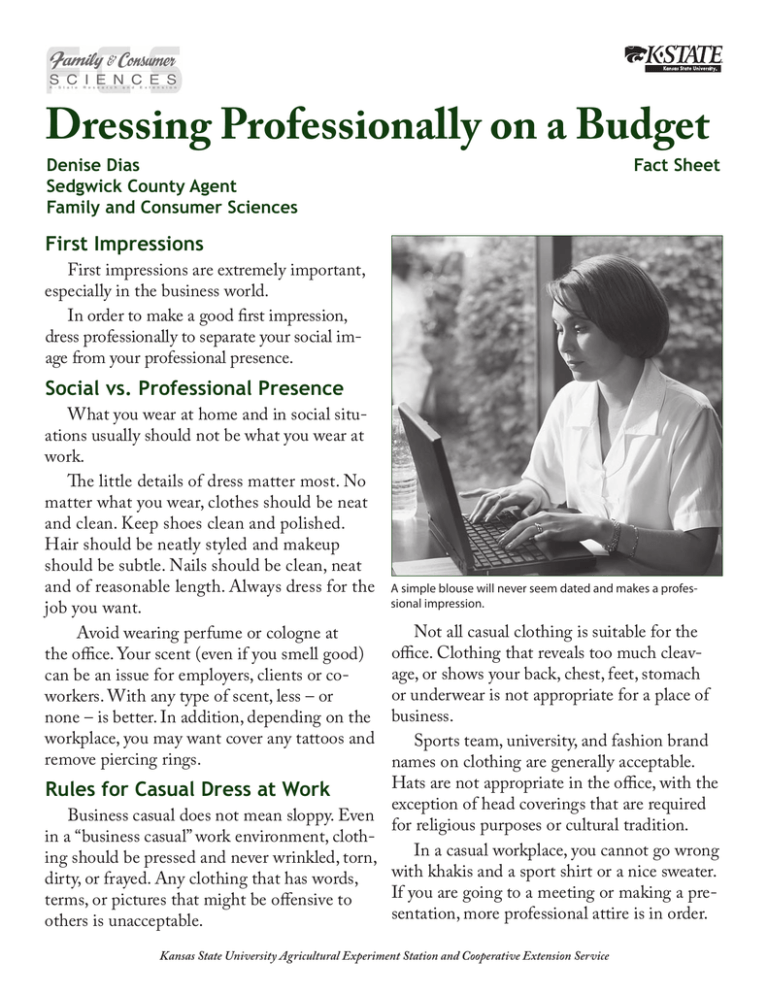
Dressing Professionally on a Budget
Denise Dias
Sedgwick County Agent
Family and Consumer Sciences
Fact Sheet
First Impressions
First impressions are extremely important,
especially in the business world.
In order to make a good first impression,
dress professionally to separate your social image from your professional presence.
Social vs. Professional Presence
What you wear at home and in social situations usually should not be what you wear at
work.
The little details of dress matter most. No
matter what you wear, clothes should be neat
and clean. Keep shoes clean and polished.
Hair should be neatly styled and makeup
should be subtle. Nails should be clean, neat
and of reasonable length. Always dress for the
job you want.
Avoid wearing perfume or cologne at
the office. Your scent (even if you smell good)
can be an issue for employers, clients or coworkers. With any type of scent, less – or
none – is better. In addition, depending on the
workplace, you may want cover any tattoos and
remove piercing rings.
A simple blouse will never seem dated and makes a professional impression.
Not all casual clothing is suitable for the
office. Clothing that reveals too much cleavage, or shows your back, chest, feet, stomach
or underwear is not appropriate for a place of
business.
Sports team, university, and fashion brand
names on clothing are generally acceptable.
Hats are not appropriate in the office, with the
Rules for Casual Dress at Work
exception of head coverings that are required
Business casual does not mean sloppy. Even
for religious purposes or cultural tradition.
in a “business casual” work environment, clothIn a casual workplace, you cannot go wrong
ing should be pressed and never wrinkled, torn,
with khakis and a sport shirt or a nice sweater.
dirty, or frayed. Any clothing that has words,
If you are going to a meeting or making a preterms, or pictures that might be offensive to
sentation, more professional attire is in order.
others is unacceptable.
Kansas State University Agricultural Experiment Station and Cooperative Extension Service
What not to wear to work
• Flip-flops or sneakers
• Visible underwear (bras, bra straps, briefs,
boxers, etc.) – even if your bra straps
match your top. Make sure the top of
underwear does not show above the pants
waistband.
• Shorts
• Jeans
• Low-rise or very tight pants
• Low-cut, midriff-baring or tight tops
Trendy vs. Classic
Classic styles will not become dated. A
classic suit that will last for years is a better
investment than trendy attire that will only last
a season. Remember that your idea of trendy
clothing might not match the boss’s perspective
on what is fashionable. Dress conservatively.
When to buy classic and trendy
Choose classic styles when purchasing bigticket items, such as suits, dresses or coats.
Trendy, but inexpensive, accessories help
you look up-to-date. Choose them in the
brightest seasonal colors. (See the wardrobe
planning tips on page 3 for more suggestions.)
A sweater and blouse are always appropriate.
Creating a Seasonless Wardrobe
Mix and match key pieces to create different looks. No two pieces should be the same,
but they should coordinate with one another.
Use accessories to pull the look together.
Two tools on the next page will help build a
wardrobe on a budget:
• Follow the steps for wardrobe planning
to clean your closet and choose the best
pieces for your work and lifestyle.
• The chart “Make the Most of Your Wardrobe” shows how a few key pieces can be
the basis for a variety of outfits.
Where to find affordable clothes
• Clearance racks
• Outlet stores
• Goodwill/Disabled American Veterans
shops
• Borrow special occasion items from a
friend
• Secondhand, thrift or resale shops
• Yard or garage sales
• A clothes exchange swap meet
2
Make the Most of Your Wardrobe
Five pieces = 6 looks
1 jacket
1 short skirt
1 pair of pants
1 blouse
1 long skirt
Seven pieces = 14 looks
2 jackets 1 short skirt
1 pair of pants
1 blouse,
2 long skirts
Eight pieces = 30 looks
2 jackets 1 short skirt 1 pair of pants
Regularly evaluate your wardrobe.
Wardrobe Planning
2 blouses,
2 long skirts
Nine pieces = 42 looks
• Get organized. Clean out and re-organize
your closet and dresser.
• Decide on a basic color plan. Neutrals are
always in style and are a good foundation
for your wardrobe.
• Evaluate your wardrobe. Take an inventory of your closet and make a list of things
you need. Buying from a list will keep you
focused and curb impulse buying.
• Plan your wardrobe for variety and flexibility. Choose a few fun pieces to keep your
wardrobe looking fresh and up-to-date.
• Determine your clothing budget. Decide
what you can afford to spend on clothes
every month, and stick to that budget.
• Buy the best quality clothes that you can
afford. They will last longer, wear better
and ultimately save you money.
• Buy basic styles because they will last
longer.
• Take care of the clothes you have. Learn
how to care for your clothes the right way.
2 jackets 1 short skirt 1 shirt 2 blouses
2 long skirts
1 pair of pants
This formula could work for a man’s wardrobe – substitute
slacks or dress pants for the skirts.
K-State Research and
Extension Publications
Basic Apparel Management, S134H
Basic Job Ready Skills, S134A
Basic Health and Wellness, S134D (Spanish S134DS
Sources for More Information
Diana Pemberton-Sikes –
http://www.FashionForRealWomen.com.
Dress Well with a Tight Budget –
http://ezinearticles.com/?Dress-Well-with-a-TightBudget&id=174381
Clothes Make the Man or Woman –
http://careerplanning.about.com/cs/dressingforwork/a/dress_
success.htm
What Not to Wear on a Job Interview –
http://jobsearch.about.com/od/interviewattire/a/interviewnot.
htm
Dress for Work Success –
http://humanresources.about.com/od/workrelationships/a/
dress_code.htm
3
Author
Denise G. Dias, Sedgwick County Extension
Agent, Family and Consumer Sciences
Reviewers:
V. Elizabeth Drescher, Sedgwick County
Extension Agent, 4-H Youth Development
Jan McMahon, Sedgwick County Extension
Agent, Family and Consumer Sciences,
EFNEP
Brand names appearing in this publication are for product identification purposes only. No endorsement is intended,
nor is criticism implied of similar products not mentioned.
Publications from Kansas State University are available on the World Wide Web at: www.ksre.ksu.edu
Contents of this publication may be freely reproduced for educational purposes. All other rights reserved. In each case, credit
Denise Dias, Dressing Professionally on a Budget, Fact Sheet, Kansas State University, August 2009.
Kansas State University Agricultural Experiment Station and Cooperative Extension Service
MF2881
August 2009
K-State Research and Extension is an equal opportunity provider and employer. Issued in furtherance of Cooperative Extension Work, Acts of May 8 and June 30, 1914, as
amended. Kansas State University, County Extension Councils, Extension Districts, and United States Department of Agriculture Cooperating, Fred A. Cholick, Director.

